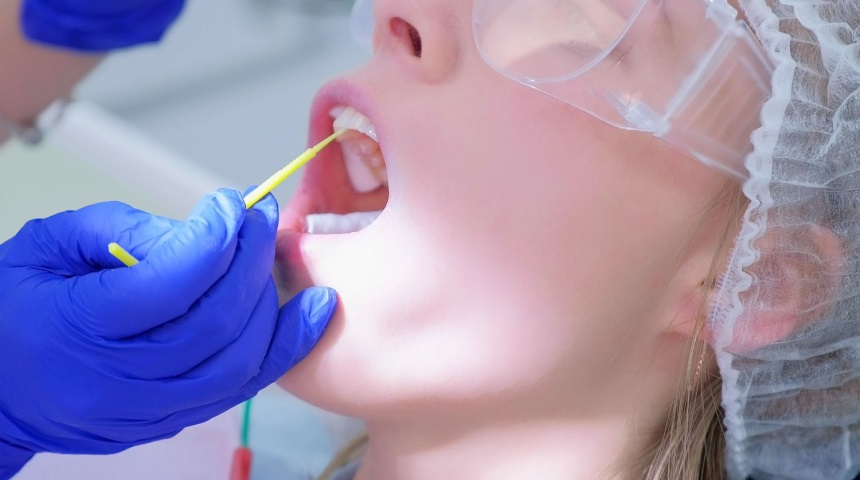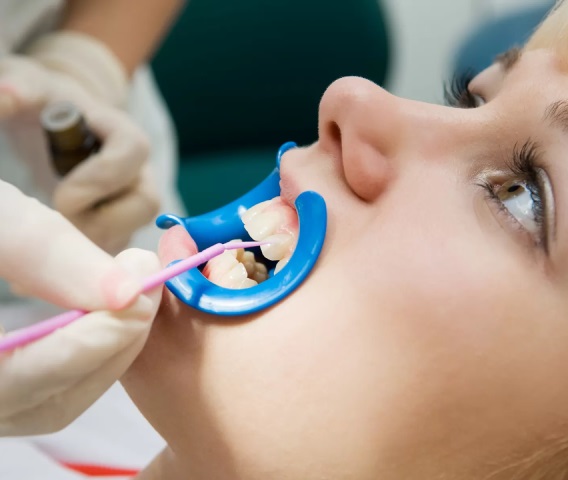General Dentistry
Fluoride Treatment

Hooray For Decay
For decades, fluoride has been held in high regard by the dental community as an important mineral that strengthens tooth enamel, which thereby helps to prevent decay of tooth structures.
Water fluoridation is endorsed by nearly every major health and safety-related organization in the world. Communities make it a standard practice to “fluoridate” their drinking supplies for the general population to benefit from this inexpensive and effective preventative treatment. According to the American Dental Association, more than 144 million U.S. residents in more than 10,000 communities drink fluoridated water, most from public water supplies with sodium fluoride added artificially.
The proponents of removing fluoride from municipal water sources evidently like dentures. In the 1930s, Americans had an extremely high rate of dental caries (the clinical term for cavities). In those years, by the age of 55 half of all Americans needed dentures, meaning they had lost all or most of their teeth thanks to decay. At 6 years of age in the 30s, 80 percent of children had an average of 14 cavities.
There was a growing flood of research that showed adding fluoride to water helped prevent decay. Grand Rapids, Michigan was selected as a test city for adding fluoride to the municipal water supply. The results covered 15 years, from 1945 to 1960. They showed a 65 percent decline in tooth decay. End of story. After Grand Rapids, just about all cities around the world adopted water fluoridation and dental health improved.
Bottled water, home water treatment systems, and fluoride exposure
Can the consistent use of bottled water result in individuals missing the benefits of optimally fluoridated water? Can home water treatment systems (e.g., water filters) affect optimally fluoridated water supplies? The answer is yes to both. Read how you can avoid some of the pitfalls that may be preventing you from getting the maximum value of fluoride, in this article from the American Dental Association.


What are the benefits of fluoride treatments?
What’s the benefit of a child not having a mouthful of fillings? What’s the benefit of having strong enamel that fights off bacteria seeking to gain a foothold? There isn’t any debate about the beneficial effect of fluoride for preventing tooth decay. In fact, if 75 years of consistent research and results aren’t enough to convince people of the science behind fluoride, what is?
Fluoride helps remineralize our teeth. That keeps the enamel strong. That helps prevent decay in a big way. That makes for a perfect smile. That’s the benefit of fluoride treatments at Dr. Wiitala’s and across the world. Don’t listen to the pseudo-scientists who make claims without a shred of evidence to back them up.
Does fluoridation also help adult teeth, or is the benefit only for children?
It was long thought that only children really benefitted from fluoride, but that has changed. While children between the ages of 6 months and 16 years get the most benefit from fluoride for preventing decay, fluoride has more recently been shown to help adults with various conditions:
Dry mouth
Certain diseases, side effects of various medications, and head and neck radiation treatments can make the mouth not produce enough saliva. This condition, dry mouth, makes it harder for food particles to be washed away and acids to be neutralized.
Gum disease
Gum disease tends to shrink the gums exposing more of the tooth and tooth roots to bacteria.
History of frequent cavities
If you’ve continued to get cavities every year or two, even into adulthood, fluoride treatments are a good idea as an adult.
Presence of crowns, bridges, or braces
Various dental prostheses can increase the person’s risk of decay damaging the teeth at the point where the crown meets the underlying tooth structure or around the brackets of orthodontic appliances.

When do children need fluoride the most?
Children between 6 months and 16 years need fluoride to help build their teeth. This is proven by dozens of research studies.
How often should a child get fluoride treatment?
Fluoride treatments are recommended by the American Dental Association to be at intervals of 3, 6, or 12 months, depending on your proclivity toward developing decay.
How often should an adult get Fluoride Treatment?
As mentioned above, once our permanent teeth have descended and emerged into the mouth, typically by the age of 8, there isn’t any risk of getting too much fluoride and fluorosis. Research has shown that adults whose enamel has thinned with time (or never was as strong) can benefit from having professional fluoride applications at the dentist. We can vary the frequency depending on your unique teeth and their proclivity toward developing decay. It’s a good idea to have us add a fluoride treatment to your usual twice-yearly professional cleanings and exams. Again, don’t be fooled by false or incorrect information about fluoride that you may see on the internet.
How is fluoride treatment done at Dr. Wiitala’s?
Dr. Wiitala provides fluoride treatments at our Scottsdale offices as a gel, foam, or varnish. Varnishes are painted on the teeth; foams are put into a mouth guard, which is worn from one to four minutes; gels can be painted on or applied via a mouthguard.
Are there any risks associated with Fluoride Treatment with Dr. Wiitala?
Fluorosis occurs when young children have too much fluoride. This can occur if children use too much toothpaste and if they swallow it instead of spitting it out after brushing. The same is true with the use of fluoride mouth rinses. Children need to be taught to not swallow these items. It’s as simple as that.
Some parents have also opted to have their children take fluoride supplements or drops. This is unnecessary — children who eat a normal diet, drink fluoridated water, and use fluoridated toothpaste will properly get all the fluoride they need to receive its amazing decay preventing benefits. There’s no need to go overboard at home.
Because children are not swallowing the fluoride treatments we provide at Dr. Wiitala’s, they are not at higher risk of developing fluorosis. Again, common sense is important here so that parents don’t react to some of the dubious claims about fluoride that are out there. Twice-yearly fluoride applications with us really help strengthen children’s tooth enamel and help prevent decay and the need for fillings.
ADA statement on FDA toothpaste warning labels
The American Dental Association`s Council on Scientific Affairs believes that one part of the warning now required on fluoride toothpaste by the Food and Drug Administration (FDA) could unnecessarily frighten parents and children and that the label greatly overstates any demonstrated or potential danger posed by fluoride toothpaste. The label language, “If you accidentally swallow more than used for brushing, seek professional help or contact a poison control center immediately,” is now required on all fluoride toothpaste. But the ADA, in a letter sent to the FDA last year, pointed out that a child could not absorb enough fluoride from toothpaste to cause a serious problem and that the excellent safety record on fluoride toothpaste argues against any unnecessary regulation.
Enamel fluorosis
According to the American Academy of Pediatric Dentistry, a child may face a condition called enamel fluorosis if he or she receives too much fluoride during the years of tooth development. Too much fluoride can result in defects in tooth enamel.
What is Dental Fluorosis?
Dental fluorosis is a condition that causes changes in the appearance of tooth enamel. It may result when children regularly consume too much fluoride during the years their teeth are forming but they have not yet broken through the gums. This occurs usually before the age of 8.
In the U.S., most cases of dental fluorosis are very mild to mild, appearing as white spots on the tooth surface that are barely noticeable or can only be spotted by a professional such as Dr. Wiitala. This in no way affects the function of the tooth.
Moderate and severe forms of fluorosis are rare, and they can cause changes to the enamel of the teeth.
Moderate cases appear as white spots covering more of the tooth surface. Severe fluorosis appears as brown spots on the teeth and the enamel can become pitted.
Only children under age 8 can develop fluorosis. Older children and adults are not at any risk.
Can Dental Fluorosis be treated?
Fluorosis causes permanent changes in the tooth appearance. These occur in the dentin of the tooth, not the enamel, so they don’t respond to teeth whitening treatments. Dr. Wiitala can address the cosmetic changes from fluorosis by using dental bonding to cover the areas affected, or the teeth can be covered with porcelain veneers.

How does fluoride protect the teeth?
Your mouth is a dynamic mine of minerals undergoing constant demineralization and remineralization. Demineralization, caused by acid attacks from plaque bacteria and sugars, leads to tooth decay. Fortunately, consuming fluoride, calcium, and phosphate in foods and water aids in remineralization, preventing decay. Fluoride, naturally present in various sources, strengthens enamel, reverses early decay, and protects children’s developing permanent teeth from acid assault.
How soon after having a Fluoride Treatment can I eat?
The idea of these treatments is to allow the enamel to absorb the fluoride. This strengthens the enamel and helps to ward off possible future decay. To allow the teeth to do so, you should not eat or drink anything for 30 minutes after your fluoride treatment at our Scottsdale offices.
These treatments can make your teeth and gums more sensitive for a few hours, so avoid foods and drinks that are extremely hot or cold until the next day. Also, avoid highly acidic foods for a day. Interestingly, these treatments (after their initial potential sensitivity) actually decrease tooth sensitivity moving forward.
What happens if a person gets too much fluoride?
There is such a thing as too much of a good thing. That’s true of eating cake. It’s also true with fluoride. Although fluoride is the best way to prevent decay and cavities, too much fluoride can result in what is called fluorosis. Fluorosis is a cosmetic condition that affects the teeth. It’s caused by too much fluoride during the first eight years of a child’s life. The affected teeth may appear mildly discolored. More severe cases have more pronounced staining and other cosmetic issues such as surface irregularities.
But fluorosis isn’t something that occurs from fluoride in municipal water supplies. It’s usually the case of inappropriate use of fluoride-containing dental products such as toothpaste and mouth rinses. Sometimes, children enjoy the taste of their fluoridated toothpaste so much that they swallow it instead of spitting it out. Also, fluoride supplements can be a problem. A little parental vigilance is usually all that’s necessary for preventing fluorosis.
How can you tell if there is too much fluoride in your water?
There isn’t, and it’s not an issue. Municipal water supplies are rigorously tested to be sure the amount of fluoride is enough to help prevent decay, but far from enough to cause anything close to fluorosis. Switching to all bottled water only exposes your children’s teeth to a much higher risk of developing decay.
CDC website provides information on community water fluoridation
People seeking information on whether their water system is fluoridated can now find out by visiting a new website at the Centers for Disease Control and Prevention (CDC). The new feature, “My Water`s Fluoride,” allows consumers in participating states to check out basic information about their water system, including the number of people served by the system and the target fluoridation level. Optimal levels recommended by the U.S. Public Health Service and CDC for drinking water range from 0.7 parts per million (ppm) for warmer climates, to 1.2 ppm for cooler climates accounting for the tendency to drink more water in warmer climates. States that are currently participating include Arizona, Colorado, Delaware, Florida, Georgia, Illinois, Indiana, Iowa, Maine, Massachusetts, Michigan, Minnesota, Nebraska, New Hampshire, Nevada, North Dakota, Oklahoma, Pennsylvania, and Wisconsin.
Schedule a Veneers Consultation Today!
If you’re interested in learning more about fluoride treatment please contact us for a consultation at (480) 657-6981 or fill out our contact us form. We will discuss your needs and concerns, and determine your best course of action.
Kind Words From Proud Patients
Great staff and Dr. Wiitala is very professional and personable
Dr Wiitala and his staff are the best – friendly, professional and knowledgeable. My family has been going to Dr Wiitala for a decade or more. It’s the best dental office ever.
Professional, excellent experience as always. Dental hygienist, Andrea thoroughly cleaned my teeth and Dr. Wiitala identified filling in need of repair before it would become a major problem down the road. This is reason I’ve been a client of Dr. Wiitala for 15+ years.
I had not been to the Dentist in quite awhile but broke a crown. Dr. Wiitala and his staff were tremendous! They were able to get me in quickly. At the appointment, everyone was friendly and professional. They communicated to me every step of the way and were able to perfectly correct my issue in a quick and painless manner! I would highly recommend Dr. Wiitala and his staff. They all were terrific!
Thank you again to Dr Wiitala and his great staff for their skilled dental care. I had my teeth cleaned by Lindsey who does a superb job, keeping my comfort in mind. I highly recommend this dental office for all your dental needs.
